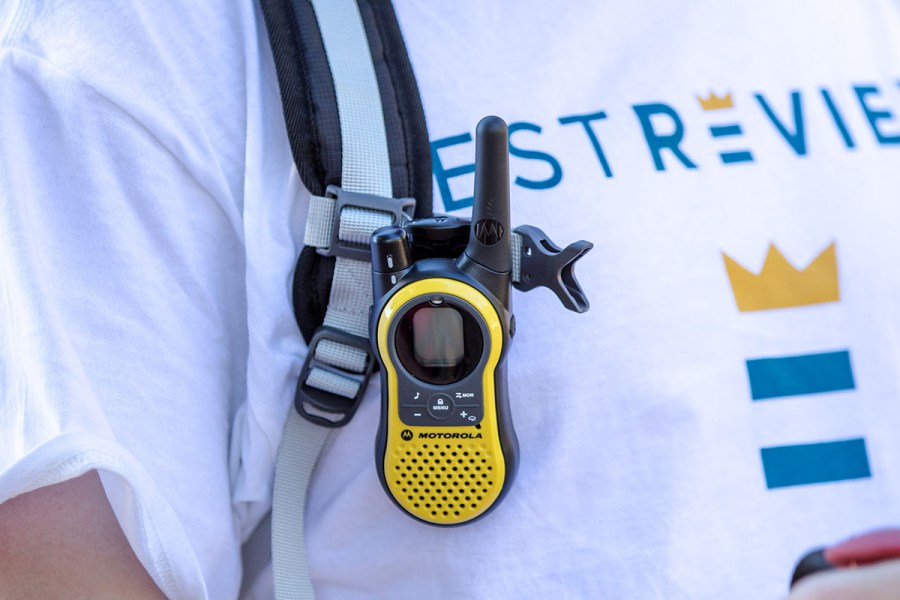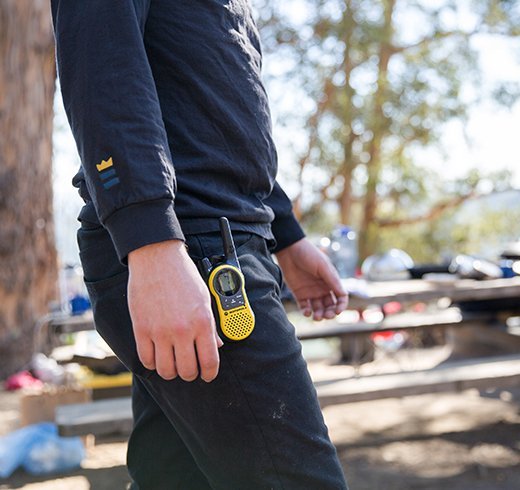Buying guide for best two-way radios
Whether for work or leisure, two-way radios are useful in situations where you need a steady stream of communication, or where cell phone use isn't practical for a variety of reasons. They're commonly used for keeping in touch while camping, hiking, or on the site of a large event.
Once you've decided to buy a set of two-way radios, the problem is finding the best one. If you're new to the world of two-way radios, some of the terminology may be confusing. IP codes, VOX support, VHF, UHF — what does it all mean?
The good news is, we at BestReviews are here to cut through the jargon and bring you fair and thorough reviews, helping you make those all-important purchasing decisions. To do so, we test products in our labs, liaise with experts, consult existing customer feedback, and do extensive research.
Types of two-way radios
You'll find two main types of two-way radio on the market: consumer and professional.
Consumer two-way radios
Consumer two-way radios are designed for leisure use — for instance, when hiking or camping, or just for fun.
Pros: Tend to be smaller and more lightweight than professional models, comparatively very affordable, perfectly adequate range for most leisure activities.
Cons: Less durable than professional models, fewer channels and frequency bands.
Price: As little as $20 for basic sets with poor range and few extra features, up to $150 for high-end models or larger sets.
Did you know?
Two-way radios with a noise filter give you a clearer signal and enhanced range.
STAFF
BestReviews
Professional two-way radios
Professional two-way radios are designed for use at work. For instance, on construction sites or by event security teams.
Pros: Have additional frequency bands reserved for business use, a larger number of channels, more rugged and durable, generally have a longer range.
Cons: More expensive than consumer two-way radios, can be quite heavy and bulky.
Price: About $60 to $500, depending on quality, range, and a number of radios per set.
All about channels and privacy codes
Two-way radios give you access to a range of channels either on the General Mobile Radio Service (GMRS), Family Radio Service (FRS), or both.
GMRS and GMRS/FRS radios have a longer range, but you'll need a license to use the GMRS channels. FRS radios have a shorter range, but anyone can use them.
Now, we get to privacy codes. The channels available to you on your two-way radio are the same channels available to anyone else with a two-way radio. So, if you're using the same channel as someone else in range, you'll hear all their communications, too. Using a privacy code adds an extra identifier to your communications, so your radio will filter out anyone who's not also using this code, even if they're using the same channel.
Two-way radios designed for personal use are often more lightweight, compact, and affordable than pro models. Professional two-way radios offer more frequency bands, greater range, and enhanced durability. They are also more expensive. We look at both types in our research.
When evaluating two-way radios, we consider the number of channels each model can utilize.
When shopping for two-way radios, many consumers look for models with relatively simple and intuitive operation. In our evaluation process, we consider the user-friendliness and functionality of each model.
Some two-way radios are compact and easy to carry. Others are heavy and cumbersome. When assessing two-way radios, we evaluate their size and how it impacts convenience.
Two-way radios vary significantly in their maximum ranges: some function at a few hundred yards; others operate across many miles. When evaluating two-way radios, we determine how range correlates with value and performance.
Some two-way radios offer voice-activated operation (VOX), which can prove useful for people on the move. We look at two-way radios with this function and assess their performance.
Many two-way radios are sold in sets. Some come in large sets of 10 or even 20 units. We take note of whether the two-way radios we like are available in large sets for bigger groups and teams.
Each two-way radio model comes with an IP rating, which tells you how well its design will protect it from solid particle damage. Because durability is important, we factor IP rating into our reviews.
In our evaluation process, we research and assess any unique features offered, such as active noise cancellation, built-in weather alerts, or a waterproof design.
Battery life is a key consideration. We find out the battery life of the various radios on our research list so customers understand what they’re getting.
IP codes: what you need to know
A two-way radio's "IP code" denotes its internationally recognized ingress protection (IP) rating. This tells you how good a two-way radio is at protecting itself from solid particles (such as dust and debris) and water. An IP code starts with the letters "IP," which are followed by two numbers. The first number is the "solid particle rating" and the second number is the "liquid ingress protection rating." But, what exactly does that mean?
Solid particle rating
Solid particle rating of 0 = Not protected.
Solid particle rating of 1 = Protected against particles of 50mm diameter or larger.
Solid particle rating of 2 = Protected against particles of 12.5mm diameter or larger.
Solid particle rating of 3 = Protected against particles of 2.5mm diameter or larger.
Solid particle rating of 4 = Protected against particles of 1mm diameter or larger.
Solid particle rating of 5 = Dust protected.
Solid particle rating of 6 = Dust-tight.
"Some two-way radios come with various accessories, such as headsets or cases — but, don't be swayed by these extras unless you wanted them anyway."
STAFF
BestReviews
Liquid ingress protection ration
Liquid ingress protection rating of 0 = Not protected.
Liquid ingress protection rating of 1 = Protected against vertically falling water.
Liquid ingress protection rating of 2 = Protected against vertically falling water when the enclosure is tilted 15 degrees.
Liquid ingress protection rating of 3 = Protected against spraying water, up to 60° from vertical.
Liquid ingress protection rating of 4 = Protected against splashing water from any direction.
Liquid ingress protection rating of 5 = Protected against jets of water from any direction.
Liquid ingress protection rating of 6 = Protected against immersion for up to 30 minutes.
Liquid ingress protection rating of 7 = Protected against continuous immersion.
Liquid ingress protection rating of 8 = Protected against high temperature, high pressure spray at a close range.
Expert Tip
You can't speak and listen at the same time on a two-way radio, so don't keep the "talk" button pressed down after you've finished speaking — you won't be able to hear the reply.
STAFF
BestReviews
Considerations for selecting a two-way radio
Range
Two-way radios may have a maximum range from anywhere between a few hundred feet to 50 miles. FRS radios have a shorter range — up to a maximum of about six miles — whereas some GMRS radios can transmit over a range of up to 50 miles. However, it's worth noting that you'll rarely ever achieve the maximum range, as conditions need to be perfect to do so.
Size and weight
Think about the size and weight of your chosen two-way radio. You want it to be comfortable to carry around with you for long periods. Check the product description for the precise weight and dimensions of your chosen model.
Caution
Bear in mind that two-way radios bought in the United States can only legally be used in North America.
STAFF
BestReviews
Hands-free operation
Some two-way radios are voice-activated, so they can be used hands-free — a feature useful for cyclists, skiers, or anyone else who might not always have a spare hand to operate the radio. This voice-activated operation is often referred to as "VOX."
Caution
It's worth noting, even when using a privacy code, anyone in range using the "monitor" feature on their two-way radio can hear your communications — so it's probably best to avoid sharing sensitive information over a two-way radio.
STAFF
BestReviews
Weather alerts
You can find two-way radios with a built-in system that lets you know about adverse weather. They constantly scan National Oceanic and Atmospheric Administration channels and update you with any weather alerts. This is particularly handy when you're out camping or hiking somewhere remote, and need to be cautious of poor conditions.
Did you know?
Most two-way radios run on AA or AAA batteries and will accept both disposable and rechargeable varieties. The battery life will depend on what kind of batteries you use — lithium ion is the best choice for longevity.
STAFF
BestReviews
Tips
If your radio has a scanning function, you can use it to quickly scan through the channels and discover which one your group is currently using.
The calling or paging feature causes each radio to ring or vibrate before the talker relays their message. This is helpful in loud places or busy situations, where it might be easy for a communication to slip through the cracks.
Very high frequency (VHF) two-way radios are generally best for long-distance use out in the open, whereas ultra high frequency (UHF) units are best for use in urban areas as the signal better penetrates through obstructions, such as buildings.
While any two-way radios that operate on the same frequency can communicate with one another, two different models may not have the same features, meaning you'll miss out on some functionality. As such, it's best to buy them in pairs or sets.
You'll get the best range if there's a clear line of sight between users — even if they're not actually able to see each other with the naked eye due to distance.
FAQ
Q. How many two-way radios will I get in a pack?
A. Two-way radios are sometimes sold singly, but they usually come in pairs or larger packs. Some packs even contain 10 or more two-way radios, for use at work or by large groups. Consider how many two-way radios you need and select a pack size accordingly.
Q. Do two-way radios have any emergency features?
A. Yes, most two-way radios have a range of features useful in an emergency. This may include all or some of the following:
- An alert function that sends emergency signals to everyone in your group.
- A "lone-worker" feature that will set off an alarm at intervals of your choosing unless you manually shut it off, just in case you injure yourself or need assistance while off on your own but can't get to your radio.
- A beacon that flashes "S.O.S." in Morse code.
- A flashlight.
Q. Do I need a license to operate my two-way radio?
A. You may need a license to operate your two-way radio, but only if you intend to use GMRS channels. The FCC issues said licenses, and they cost around $75 per person to cover the use of as many radios as you choose.
































































